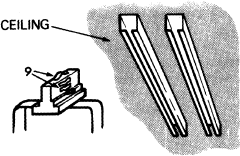Simple Lighting Supports
The lighting suspension system provides the means for positioning the luminaires in the studio. It should:
● Be of sufficient height to enable the correct lamp throw and vertical lighting angle to be achieved. (We must avoid steep or overhead lighting.)
● Allow the lighting director to position luminaires to within 0.6 m (2 ft) of any point in the studio.
● Be easy to move luminaires around the suspension system.
Floor stands
Luminaires mounted on extendable floor stands are useful for static situations but have many disadvantages. They are generally limited in height to about two metres and can obstruct cameras, boom and artistes. They are liable to be knocked, disturbing the setting of the luminaire and perhaps even causing it to fall over. Placed upstage (i.e. in distant areas of the scene) a stand- mounted luminaire has to be hidden to avoid its appearing in shot.
Despite these criticisms, however, a selecion of floor stands can prove very useful for lighting through scenic openings (windows), and where we need to add an extra luminaire quickly.
Luminaires on flats
There are various fixtures available for mounting luminaires on flats. These have two main limitations. Heavy lamps cannot be used (the scenery would probably fall over!) and, obviously, lamps can be attached only where suitably constructed scenery exists.
Telescopic tubes
This is a very flexible system but has the disadvantage that it can be used only for lightweight luminaires and where studio construction permits. It consists of concentric telescopic tubes which have large rubber pads on both ends. To use, one end of the pole, which is spring loaded, is compressed, and the pole length adjusted to the ceiling height. The spring-loaded section is then released. This jams the pole firmly between the floor and the ceiling. Luminaires can be attached to the pole, or, by using an additional vertical pole, a cross member can be fitted, to enable further lamps to be included.
Lightweight track
This system is useful for studios of limited height (up to 3 m, 10 ft). The luminaires use a special mounting which enables them to be slid along a power track fastened to the ceiling. By dividing the ceiling up with a number of separately powered tracks, good coverage of the studio can be obtained. The limitation of this system is the weight restriction on the light fittings used.
The lightweight stand (1 ) should only be used with lightweight luminaires. The ‘turtle’ (2) is used when a luminaire is to be floor mounted. Short stands (3) are also useful, as is a clamp arm which can be fitted to normal stands to enable a luminaire to be mounted lower than 1 m (3ft). Wind-up stands (4) are also used for heavy luminaires.

Scenic clamps
Lightweight lamps can be inserted into clamps attached to scenic flats. Here are two types, one to mount on the top of the flat (5), the other with a drop-arm to lower the height of the luminaire (6).

Lightweight telescopic tubes
Spring-loaded telecopic tubes (7) wedge between ceiling and floor, to support lightweight lamps. Auxiliary cross-tubes (8) can be introduced. The system provides considerable flexibility for confined spaces.

Lightweight ceiling track
Lightweight ceiling track—easy to install. Currently tracks are available which have 1, 2 and 4 separate circuits. On the multi-circuit track, connection is made to the appropriate circuit by means of sliding contacts (9).

